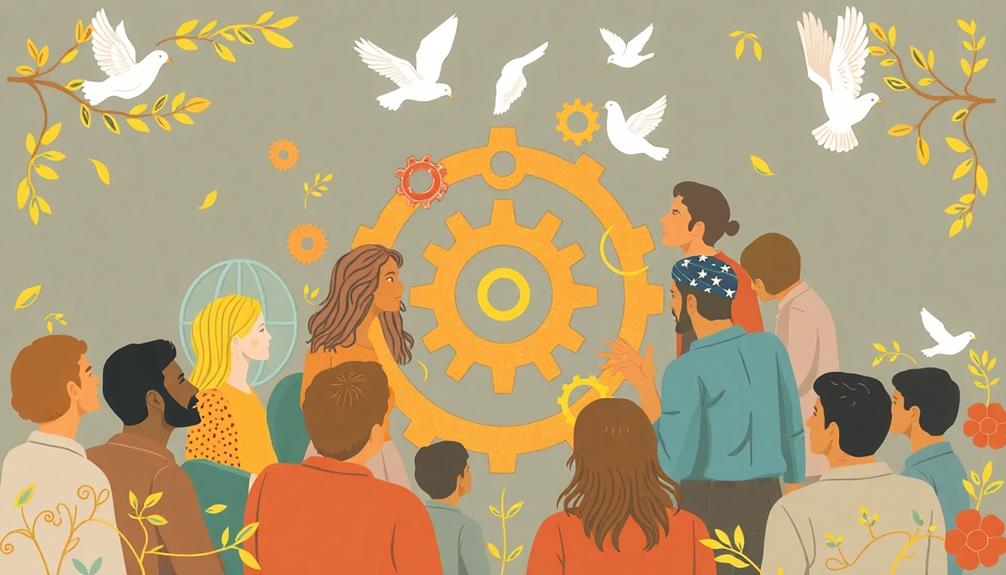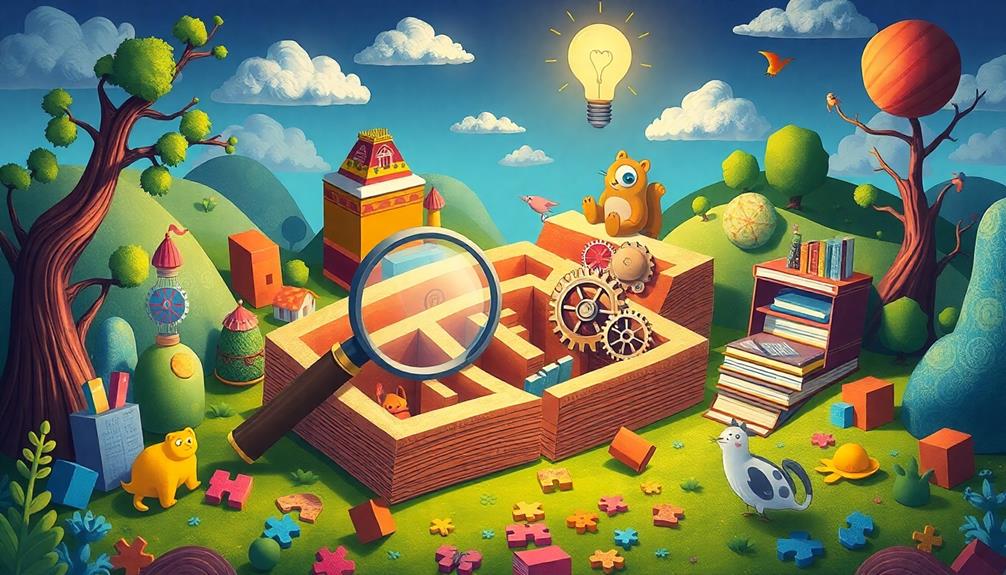Curiosity is a powerful tool for resolving conflicts. It allows you to shift from blame to understanding, helping you gain deeper insights into others' emotions and motivations. By asking open-ended questions, you uncover shared interests and foster empathy. This approach encourages productive dialogue, reduces defensiveness, and creates a safe space for vulnerability. When you prioritize curiosity, conflicts become opportunities for growth and stronger connections. Engaging actively in conversations not only calms tensions but can also lead to innovative solutions. You might find that adopting these practices opens new doors for understanding and collaboration in your own experiences.
Key Takeaways
- Curiosity fosters empathy by encouraging open-ended questions that reveal deeper emotional issues and shared interests during conflicts.
- Active listening combined with curiosity reduces defensiveness, creating a safer environment for constructive communication and resolution.
- Engaging in curiosity-driven discussions helps uncover common ground, promoting collaboration and innovative solutions to conflicts.
- Embracing curiosity transforms conflicts into growth opportunities by shifting focus from blame to understanding and cooperation.
- Cultivating a culture of curiosity enhances relationships, making open dialogue and vulnerability more achievable in conflict situations.
Understanding Creative Conflict

When you think about conflict, it's easy to see it as a negative force, but understanding creative conflict reveals its potential for growth. Embracing differences and underlying motivations transforms disagreements into valuable opportunities for learning. When you acknowledge emotions, you can use them as tools for deeper understanding and empathy, allowing you to view conflicts more objectively and collaboratively.
Recognizing the importance of clear communication during a breakup can exemplify how effective dialogue can lead to resolution, as seen in the classy way to explain a breakup.
Creative conflict fosters effective communication by encouraging you to focus on the collaborative aspect of resolution. This approach not only strengthens relationships but also opens the door to innovative solutions. By recognizing that conflict can reduce stress and anxiety, you can respond proactively rather than reactively, creating a more harmonious environment.
Curiosity can lead you to explore various perspectives and seek common ground with others. This culture of inquiry encourages you to ask questions and dig deeper, promoting mutual respect among all parties involved.
Ultimately, understanding creative conflict helps you see it not as a barrier but as an opportunity for growth and connection. Embrace this mindset, and you'll discover that conflict can pave the way for richer relationships and a more dynamic problem-solving process.
The Role of Curiosity

Curiosity can be your secret weapon in conflict resolution, allowing you to enhance empathy and transform challenging situations into growth opportunities.
By embracing the transformative power of curiosity, you open the door to deeper understanding and connection.
By asking open-ended questions and truly listening, you can uncover deeper emotional issues and shared interests.
This approach not only fosters understanding but also paves the way for collaborative problem-solving.
Enhancing Empathy Through Curiosity
In the heat of conflict, fostering empathy can feel intimidating, but embracing curiosity can transform the way you engage with others. By actively seeking to understand the emotions and motivations behind differing perspectives, you can enhance your emotional intelligence and create a more compassionate dialogue. Curiosity in conflict involves asking open-ended questions that explore underlying issues, allowing for deeper connections and shared understanding.
| Curiosity Techniques | Benefits | Outcomes |
|---|---|---|
| Asking questions | Reduces defensiveness | More constructive communication |
| Suspending judgment | Encourages emotional awareness | Enhanced empathy |
| Exploring motivations | Uncovers shared interests | Collaborative problem-solving |
When you approach conflicts with curiosity, you're more likely to discover common ground and address the real issues at hand. Engaging in curious conversations creates a safe environment for vulnerability, fostering stronger relationships. By prioritizing curiosity, you can shift from blame to understanding, ultimately transforming conflicts into opportunities for growth and connection.
Transforming Conflicts Into Opportunities
Conflict often feels like a storm, but it can be a catalyst for positive change. When you approach conflicts with curiosity, you open the door to understanding rather than defensiveness. Instead of reacting impulsively, your curiosity encourages you to explore the underlying emotions and motivations of all parties involved. This shift can transform conflicts into opportunities for growth.
By fostering an environment of open communication, curiosity allows everyone to express their viewpoints freely, reducing tension and fear of criticism. Engaging in curiosity-driven discussions can reveal hidden issues, facilitating deeper understanding and more effective conflict resolution. You'll find that asking questions not only identifies common ground but also promotes collaborative problem-solving.
As you cultivate curiosity, you enhance empathy and mutual respect, essential elements for achieving constructive outcomes. This approach not only resolves immediate conflicts but also strengthens interpersonal dynamics, paving the way for healthier relationships in the future.
Embrace curiosity during conflicts, and you'll discover that these challenging moments can lead to innovative solutions and lasting bonds.
Benefits of Curiosity in Conflict

When you approach disagreements with a curious mindset, you open the door to understanding the motivations and needs of others, which can lead to mutually beneficial solutions.
Curiosity can help resolve conflict by enhancing empathy and allowing you to explore different perspectives. This not only promotes mutual respect but also encourages improved communication between parties.
Here are some key benefits of curiosity in conflict situations:
- Empathy Growth: By seeking to understand, you can connect with others on a deeper level.
- Reduced Defensiveness: A curious approach transforms conflict into an opportunity for growth, making everyone feel safer to express their views.
- Identifying Underlying Issues: Curiosity helps you uncover valuable insights that may not be immediately visible, leading to more effective resolutions.
- Innovative Solutions: Engaging in curiosity-driven dialogue encourages brainstorming, allowing for diverse perspectives and creative problem-solving.
Ultimately, cultivating curiosity in conflict situations strengthens relationships and fosters a collaborative environment.
Strategies to Cultivate Curiosity

To cultivate curiosity in conflict resolution, start by using open-ended questions that encourage deeper exploration of issues. This approach aligns with the idea that small mistakes in communication can lead to misunderstanding, making curiosity essential for effective dialogue.
You'll find that practicing active listening not only validates others' viewpoints but also enriches your understanding. Together, these strategies create an environment where curiosity can thrive, leading to more effective resolutions.
Embrace self-care by taking time to reflect on conflicts and your role in them.
Open-Ended Questioning Techniques
Curiosity can be a powerful tool in resolving disagreements, and open-ended questioning techniques play a significant role in this process. By using open-ended questions, you encourage deeper exploration of issues, allowing individuals to share their thoughts and feelings without limitations. This approach fosters a thorough understanding of the conflict and reveals underlying motivations essential for conflict resolution.
Here are some effective open-ended questions to reflect on:
- What're your thoughts on the situation?
- How did that make you feel?
- Can you explain why you see it that way?
- What do you think would help resolve this issue?
These questions create a safe space for dialogue, promoting an environment where conflicting parties feel comfortable expressing themselves.
While you practice open-ended questioning, remember that active listening is equally important. Validating the speaker's perspective enhances communication and builds trust.
Active Listening Practices
Active listening is like a bridge that connects you to the speaker's thoughts and feelings. It involves fully concentrating, understanding, responding, and remembering what's being said. To cultivate curiosity, you need to seek to understand rather than just waiting for your turn to speak. Here are some practical tips to enhance your active listening skills:
| Strategy | Description | Benefits |
|---|---|---|
| Ask Questions | Use open-ended questions to encourage elaboration. | Promotes deeper dialogue. |
| Reflective Listening | Paraphrase or summarize the speaker's points. | Helps clarify understanding. |
| Nonverbal Cues | Maintain eye contact and nod to show attentiveness. | Makes the speaker feel heard. |
Techniques for Effective Resolution

Effective conflict resolution often hinges on specific techniques that promote understanding and collaboration. By employing curiosity, you create an environment where open dialogue can flourish.
Start by utilizing active listening techniques, ensuring you truly hear and reflect on what others say. This validates their perspectives and helps you grasp the nuances of the conflict.
Incorporate open-ended questions to uncover underlying issues and motivations. This encourages all parties to express their thoughts freely, leading to a more thorough understanding of the situation.
Identifying common ground is essential; it can spark innovative solutions that address everyone's needs.
Consider the following techniques for effective resolution:
- Practice active listening by summarizing key points and reflecting emotions.
- Ask open-ended questions to investigate deeper into the conflict.
- Cultivate curiosity to explore common ground among differing viewpoints.
- Review outcomes and provide constructive feedback to foster continuous learning.
Challenges in Fostering Curiosity

One's natural inclination to react defensively often presents a significant hurdle in fostering curiosity during conflict resolution. This defensiveness can block open communication, making it difficult to explore different perspectives.
Emotional barriers, like fear of vulnerability or past negative experiences, can hinder your ability to ask curious questions when tensions rise. You might find yourself holding back, which reinforces misunderstandings and stifles meaningful dialogue.
Moreover, resistance to change can be a significant obstacle. When you're entrenched in your viewpoint, you might resist considering alternative solutions, limiting the power of curiosity.
Misinterpretations can also arise; curiosity might be seen as disrespect or aggression, further escalating tension instead of fostering understanding.
Without a culture that encourages inquiry, individuals may feel unsafe exploring underlying issues during conflicts. This environment can make it challenging for you and others to engage in open communication, ultimately stifling curiosity.
Recognizing these challenges is the first step towards addressing them and creating a more conducive atmosphere for conflict resolution. By overcoming these barriers, you can promote a healthier dialogue and pave the way for more effective resolution strategies.
Importance of Open Communication

Open communication is essential in maneuvering conflicts, as it allows you to express your needs and feelings with clarity and empathy. When you engage in open dialogue, you create a space for understanding and connection, transforming conflict into an opportunity for growth.
To effectively navigate conflicts, consider these key elements:
- Listen actively to your partner's perspective, validating their feelings and fostering a supportive environment.
- Establish clear expectations to prevent misunderstandings and reduce potential resentment.
- Use nonverbal cues effectively, as your body language can greatly impact the message you're conveying.
- Regularly appreciate and acknowledge each other's viewpoints to strengthen your relational bonds.
Case Studies in Practice

Building on the importance of open communication, case studies reveal how curiosity-driven conflict resolution strategies can greatly enhance interpersonal dynamics within organizations.
For instance, a tech company that prioritized curiosity saw a 40% reduction in employee turnover. When team members felt valued and understood, they engaged more fully, fostering a collaborative environment.
In another study, teams employing curiosity techniques during conflicts reported a 75% increase in collaboration and a significant decrease in misunderstandings. When you encourage open-ended questioning during discussions, research indicates that resolution can occur 50% faster compared to relying on directive communication.
A nonprofit organization that integrated curiosity into their conflict resolution process experienced a 60% decrease in reported conflicts, showcasing how curiosity can transform interactions and lead to innovative ideas during team meetings.
These case studies highlight that by embracing curiosity, you not only enhance understanding but also create a culture where conflicts become opportunities for growth and resolution.
Ultimately, implementing curiosity-driven strategies can lead to a 30% boost in employee satisfaction, proving that curiosity isn't just a soft skill—it's a powerful tool for effective conflict resolution.
Frequently Asked Questions
How to Approach Conflict With Curiosity?
When you face conflict, start by asking open-ended questions to understand the other person's perspective.
Listen actively, reflecting on what they say to build empathy.
Keep an open mind, viewing the situation as a chance to learn and grow.
Stay emotionally neutral to manage your reactions effectively.
Create a safe space for dialogue, allowing everyone to express their thoughts freely.
This approach fosters understanding and paves the way for resolution.
What Is the Most Effective Tool in Conflict Resolution?
The most effective tool in conflict resolution is open communication. When you engage in honest dialogue, you foster understanding and clarity.
It's essential to listen actively and express your thoughts clearly. By addressing the issues directly, you can identify underlying concerns and motivations.
This approach not only reduces misunderstandings but also builds trust between parties. Remember, the goal is to find common ground and collaborate on a solution that satisfies everyone involved.
What Are the 4 C's of Conflict Resolution?
The 4 C's of conflict resolution are Communication, Collaboration, Compromise, and Creativity.
You'll want to start with effective Communication, actively listening and expressing your needs clearly.
Then, focus on Collaboration, working together to find mutually satisfying solutions.
Next, consider Compromise, where both parties make concessions to reach an agreement.
Finally, embrace Creativity, exploring innovative ideas and diverse perspectives that lead to effective problem-solving.
These elements can transform your approach to resolving disputes.
What Are the 5 A's of Conflict Resolution?
Imagine a team at work struggling to meet a deadline due to miscommunication.
The 5 A's of conflict resolution can guide you: first, Acknowledge the conflict and everyone's perspectives.
Next, Assess the underlying issues causing the chaos.
Then, Address the situation through open dialogue to clarify misunderstandings.
After that, Act by implementing a solution.
Finally, Analyze the outcome to identify lessons learned for future conflicts.
This structured approach fosters collaboration and resolution.
Conclusion
Curiosity can either be a bridge or a barrier in conflict resolution. When you embrace curiosity, you open doors to understanding, transforming tension into collaboration. However, without it, misunderstandings fester, leading to deeper divides. As you cultivate curiosity, you not only enhance your conflict resolution skills but also foster a culture of open communication and empathy. So, the next time conflict arises, remember: your curious mindset can turn a heated clash into an opportunity for growth.









